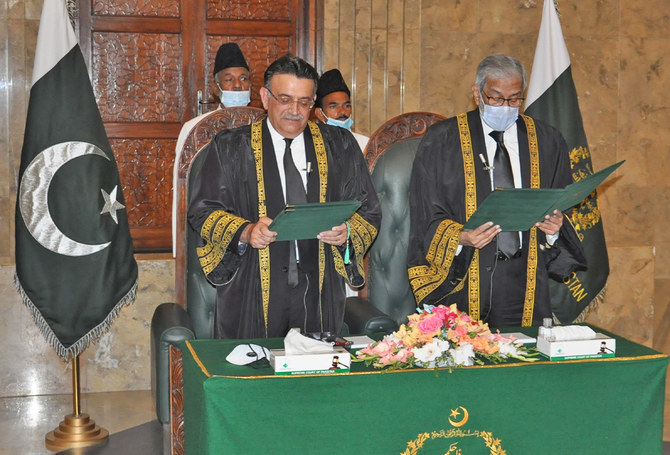— Justice Qazi Faez Isa will replace the coming chief justice in September 2023
— Justice Ayesha Malik will become nation’s first woman top judge in January 2030
ISLAMABAD: Justice Umar Ata Bandial of the Supreme Court will take oath as the next chief justice on February 2 (Wednesday) as the incumbent Gulzar Ahmed will hang his robe on Tuesday after two years and 42 days in office.
He was appointed to the highest judicial office in the land on December 21, 2019.
Justice Bandial will serve in the top judicial office until September 16, 2023, when he is due to be replaced by Justice Qazi Faez Isa.
In 2019, Justice Isa delivered a landmark, and unprecedented, verdict in the 2017 Faizabad sit-in case, warning the security agencies not to exceed their mandate and meddle in politics, an apparent rebuke over their handling of five-week-long Tehreek-e-Labbaik Pakistan (TLP) protest.
When elevated to the top judicial office, Justice Bandial will face a veritable mountain of 51,766 cases pending before the Supreme Court alone.
The total backlog of cases in the national judiciary, including the superior courts as well as district courts, stands at a whopping 2.1 million.
Seven justices of the higher courts, including Justice Ahmed, will retire in 2022. These include five justices of the apex court and two of the Lahore High Court (LHC).
The Supreme Court justices retire after reaching the age of 65 years while the high court judges leave the office at 62.
After Justice Ahmed, Justice Qazi Muhammad Amin Ahmed of the Supreme Court will retire next on March 5, Justice Maqbool Baqar on April 4, Justice Mazhar Alam Khan Miankhel on July 13 and Justice Sajjad Ali Shah on August 13.
Justice Sardar Ahmad Naeem of LHC will hand his robe on June 30, and Justice Chaudhry Masood Jahangir will retire on December 2.
Out of the total strength of 17 justices, seven will have the opportunity to become the chief justice while the remaining 10 will retire as Supreme Court judges.
As per the scheme of seniority, Justice Isa would retire on October 25, 2024, and be replaced by Justice Ijaz ul-Ahsan who would assume the office for 282 days.
Then, on August 4, 2025, the post would go to Justice Syed Mansoor Ali Shah who would remain in office until November 27, 2027, before being succeeded by Justice Munib Akhtar.
Justice Yahya Afridi would be the nation’s next top judge from December 14, 2028, until January 22, 2030.
The newly-elevated Justice Ayesha A. Malik will become Pakistan’s first female chief justice on January 23, 2030. She would keep the office until June 2, 2031.
WHO IS JUSTICE BANDIAL?
Born on September 17, 1958, in Lahore, Justice Bandial received his elementary and secondary education in Lahore, Kohat, Rawalpindi and Peshawar.
“He secured his B.A. (Economics) degree from Columbia University followed by a Law Tripos degree from Cambridge University and qualified as Barrister-at-Law from Lincoln’s Inn,” the Supreme Court’s website read.
In 1983, Justice Bandial enrolled as an advocate of the LHC and later, as an advocate of the Supreme Court.
As a lawyer at the high court, he dealt mostly with commercial, banking, tax and property matters. He also handled international commercial disputes and appeared in arbitration matters before the Supreme Court of Pakistan and international arbitral tribunals in London and Paris.
Bandial was elevated as a judge of the LHC on December 4, 2004. He is one of the judges who refused to take oath under the Provisional Constitutional Order (PCO), issued by then-president Pervez Musharraf in November 2007.
He was reinstated as a judge of the LHC after the lawyers succeeded in their movement for the restoration of the judiciary and Constitution against the Musharraf government.
Justice Bandial served as the chief justice of the LHC for two years until his elevation as a judge of the Supreme Court in June 2014.
During his stint as a judge of the high court and the apex court, Justice Bandial has issued judgments on a number of civil and commercial disputes, and in constitutional rights and public interest cases.























